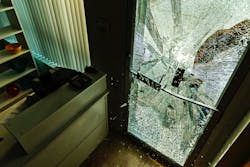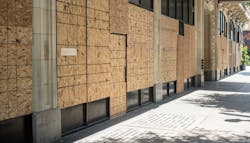Since late May, many communities across the country have experienced civil unrest. This article does not address the racial or political aspects associated with the current state of our country; however, it does provide information and strategies on how security and monitoring companies operate in this type of environment and how to work with law enforcement and end-users to best protect life and property.
On May 26, protests and civil unrest started in Minneapolis in response to the killing of George Floyd. These protests quickly spread and took place in more than 2,000 U.S. cities and towns. Protests have continued and as of July 3, and a number of polls have been conducted that indicate between 15 million (Pew poll) and 26 million people (Kaiser Family Foundation poll) have participated in these demonstrations.Most have been peaceful in nature; but unfortunately, some have escalated into looting and rioting. This article will focus on the areas of Santa Monica and Huntington Beach, Calif., on May 31, as well as the overnight hours of May 30 and 31 across Los Angeles County, as an example of what our industry was tasked with managing through these disturbances; however, it is important to note that civil unrest tends to happen from time to time in the United States, and security companies have an obligation as a trusted advisor to consider that fact as they secure and help customers prepare for the future.
The Impact for an Alarm Company
Glendale, Calif.-based Armet Alarm & Electronics Inc., which has served both residential and commercial customers for nearly 40 years, had several customers who were affected by rioting. “Armet Alarm does its best to ensure that every customer feels as safe and protected as possible; unfortunately, we have to face a certain truth that no matter how much effort is put into a burglary alarm system or video surveillance, the system only maxes its potential as a buffer to those who would try to do something to the property,” explains VP Sooren Achemian. “A handful of businesses belonging to our customers were burglarized or vandalized during the recent riots; however, their alarm and video surveillance systems functioned properly and were not damaged in the majority of the cases.”
Achemian says that Armet has seen an influx of customers proactively reaching out about additional security options for both homes and businesses in the wake of the incidents. “For the customers not immediately affected by or located in the areas impacted by the looting, we have received more than the usual number of requests for increased protection equipment, such as remote or stationary panic buttons,” he says. “We also received a number of calls from customers who wanted to start using their alarm system on a stay mode while in the residence and needed guidance on the process.”This is a great reminder for all alarm companies that customers are likely to be more open to upgrades and additional security products because they do not feel as safe as they may have just a few months ago. This applies both to civil unrest situations as well as COVID and other outside forces that threaten the security and safety of homes and businesses.
Guard Services Company Reacts
Chuck Landfried, President of California-based Private Security – which offers experienced alarm response and armed/unarmed patrol officers in highly visible, marked patrol vehicles that are GPS tracked for proof of service – points out that it is difficult to prioritize alarm dispatches during these times. Private Security handles them in the order they are received unless there is some higher level of service that the customer has purchased in advance.
Landfried says he has purchased cameras for his full fleet of more than 30 vehicles, and he is also in the process of purchasing Axon body cameras – used by most law enforcement agencies – for all of their officers. They were also approved for and are upgrading their communications to the AT&T First Net responder program.
Landfried adds that the company is making sure officers have police scanners with them at all times. “During civil disturbances, we have all upper management on duty and in the field, and we have multiple retired law enforcement officers who were supervisors with their departments, monitoring the scanners to keep our staff out of harm’s way,” Landfried explains, adding that he highly recommends that alarm companies install video verification that must go to the central station and link to the alarm activation to determine if response is needed or not.
Private Security is also supplementing its officers with video wherever possible. During civil disturbances, it is incredibly difficult to actually protect a specific property; however, the officers and staff serve an important role in observing and reporting what takes place.
Since most police departments lack the ability to receive an automated alert, verify it and dispatch law enforcement to that location, Landfried says he would love to see more integrations with police departments on this front. “These are areas of opportunity where improvements could speed up response times and increase the safety of the public and law enforcement,” he says.
Lastly, Landfried advises that it is a great time for security providers to review contracts to make sure the company is covered with the different scenarios that can occur during protests and rioting.
Monitoring Centers
In my capacity as President of General Monitoring Services (GMS), the most important piece of advice that I can give other monitoring centers is to always have a well-vetted emergency response plan in place. Being prepared for situations like riots is critical to provide integrators and end-users with the best possible service under such unusual conditions.
Beyond just having an emergency response plan, you must also test the plan regularly to ensure it works and evaluate areas for improvement. The dynamics of a central station are constantly changing from new operators, managers, technology, AHJ requirements and incidents happening in your service areas.
As a direct response to the civil unrest in the areas we monitor, GMS increased staffing – mostly on our third shift, as that was where we saw most of the protests escalate into rioting and looting that caused a flood of alarm signals in concentrated areas of our footprint. Some staff volunteered to take on more hours, and in some cases, we needed to mandate that team members help fill the gaps.
We also worked with our alarm company partners to make them aware of the issues, and in some cases, we implemented special temporary procedures – such as placing signals that are in runaway status on disregard; and moving all non-priority events (for example trouble signals, or anything non-dispatchable) to disregard for a set period of time until our operators were able to shift their attention back to these lower priority activities.
We experienced concentrated geographic areas that were affected more severely than others. This enabled us to separate the signal traffic in those areas into their own queue so that the rest of the base was not affected and we were able to maintain our service levels in the areas that were not experiencing rioting. In this scenario, we were running two separate monitoring teams and balancing the activity load as needed.
Training is critical when a monitoring operation must deal with an influx of unusually high activity all at once. We train operators to remain calm and help calm customers who may be in a frantic state. During riots, we see police response times slow dramatically, which is understandable because they literally cannot respond to every call while working to restore peace. This is very challenging forThese situations can become very stressful and emotional. One of our alarm companies had a dozen customers that were looted in a short period of time. Operators were experiencing hold times of up to 30 minutes with police departments when trying to dispatch, while law enforcement informed operators that they were in the area and they were doing their best to respond. At one point, the police department lines went down, causing our operators to go through the fire department to dispatch.
After a few intense nights, alarm activity returned to normal. We then formally de-briefed with our teams to evaluate how our plan performed and to implement new, improved procedures based on what we learned – this is a critical step that any company providing monitoring should take.
In addition, it is incredibly important to take care of employees – they experience immense stress in these situations, and it is vital to check in and make sure they have the resources they need to recover. This goes beyond making sure they are paid well; in fact, these stressful events often produce opportunities to recognize those who go above and beyond. Look for operators and employees who stepped up and volunteered to help; who handled a particularly difficult call properly and maybe even helped a customer more than was required.
Impact on End-Customers
While the impact is often dramatic, overall, the majority of end-user customers who were victims of looting tended to be understanding. At the time of the incident, they were in a heightened state of emotion – ranging from panic to extreme urgency – but they understood the situation and that the police were doing everything they could.
Some customers felt hopeless watching it all unfold on their cameras, but our operators reminded them that the footage was being stored so the police could use it in a subsequent investigation. Many customers also authorized our operators to disable the response actions for the rest of the night, in an effort to work with law enforcement to reduce the number of calls to the police.
Law Enforcement’s Perspective
Michelle Palladini is a police officer and detective as well as the founder of the L.E.A.P training program, developed to provide a solution-focused method for authentically connecting the police with the communities they serve. She trains law enforcement departments across the country and is an expert in community policing.Palladini explained that even during social unrest, her department like most others continue their standard response protocol which is a tiered response that is assigned to alarms. “Verified alarms with audio and/or video take priority over unverified alarms,” Palladini explains, adding that she sees an opportunity to provide even more information for officers when dispatching alarms. “Quickly providing active video, audio and any additional details are critical to ensure the safety of the officers and those they are responding to help.”
As mentioned, law enforcement response to rioting is incredibly challenging – they are often drastically outnumbered and must protect victims who are caught up in the chaos, disperse the crowds, reinstate peace and minimize the damage. Since law enforcement is typically unable to respond to every alarm, this is where video becomes critical and extremely valuable to investigators.
Palladini encourages alarm companies to install video cameras wherever possible. It allows officers to use the information for investigation once peace has been restored and there is no immediate danger.
“Video enables officers to focus, gain perspective, conduct a more skilled investigation, and it creates a record of crime and potentially proof and evidence,” Palladini explains, adding that now is a great time for law enforcement and security companies to work with business owners to educate them on the advantages of video and other security precautions.
“I highly recommend working with responding agencies to develop a camera registry to build out a community map where business owners can register the location of security cameras,” Palladini says. “Police officers and investigators can then call on recorded video to help in other crimes and investigations, and it also works as a deterrent to potential criminals if it is well known that the area is covered by cameras.”
Palladini goes on to explain that the security industry, law enforcement, residents and business owners all need to work together, because they are all part of the same community. ““I firmly believe that public service equals public safety,” she says. “Taking it a step further, understanding the needs of the community and creating a dialog with alarm companies and users on how best to work together with law enforcement to remove the silos (us vs. them) and take a holistic view of public service as a whole will help to improve public safety.”
Moving Forward
As a security company owner, your next step should be to engage with local police, your internal or third-party central station, as well as your end-customers to initiate an active conversation about how to provide the highest levels of service and security both now and in the future. Use the best practices from each of the areas and experts above as your guide.
This is not the first, and it will not be the last time we are faced with challenges in our industry – both to our customers’ wellbeing and to the validation of the services we charge for – so there is still work to be done. As a network of trusted security advisors, we can build a much larger community focused on the same goals resulting in additional value to our customers.
Robert Few is Managing Partner of The Connection Xchange (TCX), where he works with top security and integration companies as well as MSOs, ISPs and other non-traditional companies looking to enter the connected home and security markets. He is also President of General Monitoring Services. Contact him at (201) 838-0091, [email protected] or visit www.securityinfowatch.com/21111763 to request more info.









